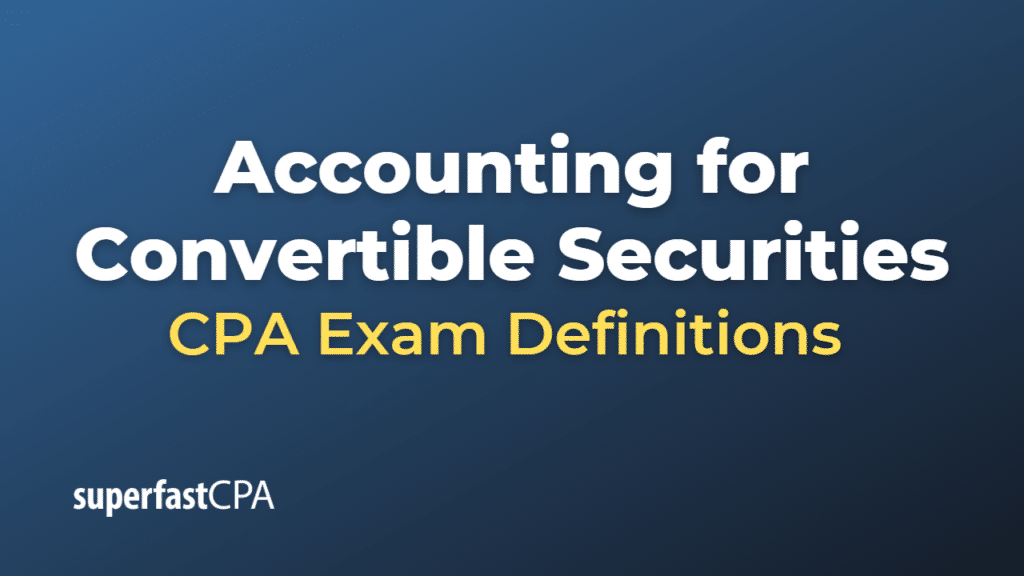Accounting for Convertible Securities
Accounting for convertible securities involves the proper recognition, measurement, and disclosure of financial instruments that can be converted into other securities, typically common stock, at the option of the holder. Convertible securities often come in the form of convertible bonds or convertible preferred stock. These securities provide the holder with the potential benefit of participating in the issuer’s future stock price appreciation while still receiving the fixed income or dividends associated with debt or preferred stock.
Accounting for convertible securities can be complex and generally involves the following aspects:
- Initial recognition: When a company issues convertible securities, it records the proceeds received as a liability (for convertible bonds) or equity (for convertible preferred stock). The initial carrying value of the convertible security is typically recorded at its fair value or the present value of future cash flows (interest or dividend payments) discounted at the market rate for similar non-convertible securities.
- Allocation of proceeds: In some cases, the convertible security may be separated into its debt or equity component and the conversion feature (conversion option). The issuer allocates the proceeds received from issuing the convertible security between these components based on their relative fair values. The conversion feature is recognized as a separate component of equity.
- Interest or dividend expense: The company recognizes interest expense on convertible bonds or dividend expense on convertible preferred stock over the life of the security. The interest or dividend expense is based on the effective interest method, which takes into account the initial carrying value of the security and the market interest rate for similar non-convertible securities.
- Conversion: When the holder of a convertible security chooses to exercise the conversion option, the company adjusts its financial statements to reflect the conversion. For convertible bonds, the carrying value of the liability is removed, and the common stock and additional paid-in capital accounts are increased to reflect the issuance of new common shares. For convertible preferred stock, the carrying value of the preferred stock is removed, and the common stock and additional paid-in capital accounts are increased accordingly.
- Financial statement disclosure: Companies must disclose information about their convertible securities in the notes to the financial statements, including the terms of the securities, the carrying amounts, and any conversions that occurred during the reporting period.
Accounting for convertible securities ensures that the financial statements of the issuer provide a transparent and accurate representation of the company’s financial position, performance, and potential dilution of ownership interests due to conversions.
Example of Accounting for Convertible Securities
Let’s consider an example of a company issuing convertible bonds.
Example: ABC Corporation issues $10 million of 5-year convertible bonds with a 4% annual interest rate. Each bond has a face value of $1,000 and is convertible into 50 shares of ABC Corporation’s common stock at any time at the option of the bondholder. The market interest rate for similar non-convertible bonds is 6%.
Step 1:
Initial recognition: ABC Corporation records the proceeds from the issuance of the convertible bonds as a liability. The initial carrying value of the bonds is calculated based on the present value of future interest payments and principal repayment discounted at the market rate of 6% for similar non-convertible bonds.
| Debit: Cash | $10,000,000 |
| Credit: Convertible Bonds Liability | $10,000,000 |
Step 2:
Allocation of proceeds: Assume that the fair value of the conversion option is $1 million. In this case, the company allocates the proceeds between the bonds liability and the conversion feature (equity component).
| Debit: Convertible Bonds Liability | $1,000,000 |
| Credit: Equity – Conversion Option | $1,000,000 |
Now, the Convertible Bonds Liability account has a carrying value of $9 million, and the Equity – Conversion Option account has a balance of $1 million.
Step 3:
Interest expense: ABC Corporation recognizes interest expense on the convertible bonds over the life of the bonds using the effective interest method. The interest expense is based on the carrying value of the bonds ($9 million) and the market interest rate for similar non-convertible bonds (6%).
Step 4:
Conversion: If a bondholder decides to convert their bond into common stock, ABC Corporation adjusts its financial statements to reflect the conversion. Assuming one bond is converted, the following journal entry would be made:
| Debit: Convertible Bonds Liability | $1,000 |
| Credit: Common Stock | $500 |
| Credit: Additional Paid-in Capital | $500 |
In this example, the liability related to the convertible bond is removed, and the common stock and additional paid-in capital accounts are increased to reflect the issuance of 50 new common shares.
Step 5:
Financial statement disclosure: ABC Corporation should disclose information about the convertible bonds in the notes to the financial statements, including the terms of the bonds, the carrying amounts, the fair value of the conversion option, and any conversions that occurred during the reporting period.
By properly accounting for convertible securities, ABC Corporation provides users of its financial statements with a transparent and accurate representation of the company’s financial position, performance, and potential dilution of ownership interests due to conversions.













